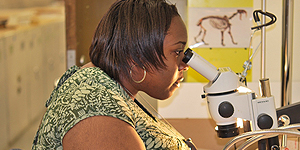By Chanika Symister
My name is Chanika Symister and I am currently working as a Research Assistant for the PCP PIRE. In 2007, I applied for the University of Florida South East Alliance for Graduate Education and the Professoriate (SEAGEP) Research Experience for Undergraduates (REU). The SEAGEP encourages minority participation in STEM disciplines so I did not hesitate to file an application for the research

I was selected to be an intern in the Vertebrate Paleontology Department of the Florida Museum of Natural History. Although I was a Biology major working on a minor in Radiochemistry, I had no previous background in fossil preparation, collections, or exhibits. However, I believed that paleontology was an underrepresented STEM discipline and figured that it would be an “eye-opening” experience.
The scope of the internship featured working on a travelling exhibit that was being introduced to the museum on the largest predatory shark that ever lived: “Megalodon.” I was very ecstatic because I was also given the opportunity to be a summer camp counselor for children who frequently visited the museum. I was fortunate enough to work alongside Dr. Bruce MacFadden who is currently the PI/PD of the PCP PIRE. He was extremely encouraging and made my experience during the summer very enjoyable. It was inevitable that post-graduation, my first thought was to continue the work that I did at the museum with fossil enthusiasts who took pride in outreach and science education.
My current position with for the PCP PIRE entails assisting in organizing Panama travel arrangements, contributing to the newsletter and other outreach initiatives, preparing excavated fossils, and participating in fossil analyses and museum cataloguing.
I am extremely grateful that I kept in contact with Dr. MacFadden and can be an asset to the PCP PIRE to aid in the achievement of the research and outreach goals of the project.
Por Chanika Symister
Mi nombre es Chanika Symister y actualmente trabajo como asistente de investigación en el PCP-PIRE. En el 2007 me presenté a la Experiencia en Investigación para Estudiantes de Pregrado, REU, de la Alianza Sureste de la Universidad de la Florida para la Educación y el Profesorado de Posgrado, SEAGEP, (ambas por sus siglas en inglés). SEAGEP, fomenta la participación de las minorías en disciplinas relacionadas con Ciencia, Tecnología, Ingeniería y Matemáticas, STEM, (también por sus siglas en inglés), por lo que no dudé en presentar mi solicitud para la oportunidad en investigación.

Fui seleccionada para ser una pasante en el departamento de Paleontología de Vertebrados en el Museo de Historia Natural de la Florida. Aunque mi énfasis era en biología con una electiva en Radioquímica, no contaba con experiencia en preparación de fósiles, colecciones o exhibiciones. Sin embargo, pensé que sería una buena experiencia para abrir los ojos a la Paleontología, lo cual era una disciplina subrepresentada en las áreas STEM.
La pasantía ofrecía trabajar en una exhibición itinerante que estaba empezando en el museo, acerca del tiburón más grande que haya existido: el Megalodón. Yo estaba muy emocionada porque también tuve la oportunidad de trabajar con niños en el campamento de verano del museo. Fui afortunada de trabajar con Bruce MacFadden PhD., quien es actualmente el investigador principal del PCP PIRE. El me motivó mucho e hizo mi experiencia muy agradable durante el verano. Fue inevitable que después de mi graduación, considerara inmediatamente continuar con el trabajo que hice en el museo con los apasionados por los fósiles, quienes se enorgullecen de divulgar y enseñar las ciencias.
Mi actual labor con el PCP PIRE incluye asistir en la organización de viajes a Panamá, contribuir con el boletín y otras iniciativas de divulgación, así como colaborar en la preparación, análisis y catalogación de fósiles.
Estoy muy agradecida de haber mantenido contacto con Bruce MacFadden y de poder ser de ayuda para alcanzar los objetivos de investigación y divulgación del proyecto PCP PIRE.